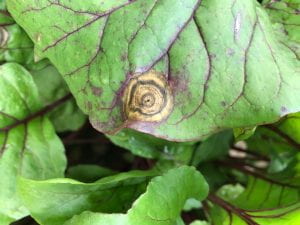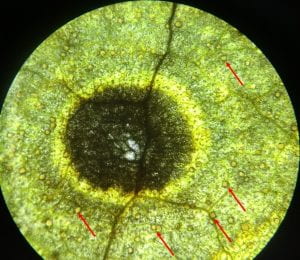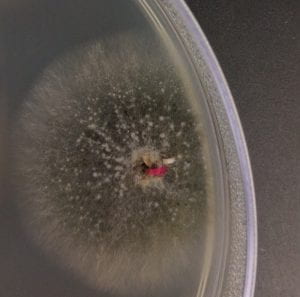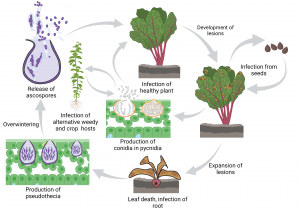Printer-friendly .pdf version of this factsheet
Pathogen
Phoma leaf spot and root rot is caused by the fungus, Phoma betae.
Host
Table beet, Sugar beet, Spinach, Swiss chard, and Lambsquarter.
Significance
P. betae can infect table beet at all stages of growth. Phoma leaf spot lesions may cause rejection for fresh market sales. Seedling infections result in damping-off and reduced plant population. Phoma root rot can cause abnormal root shape development reducing the quality of the beets. Diseases roots do not store well.


Symptoms
Early season infection can lead to seedling blight and damping-off. Foliar symptoms include tan-brown lesions with dark concentric rings in leaves and petioles (Fig. 1A). These dark concentric rings contain fruiting bodies of the fungus called pycnidia, which produce the asexual spores called conidia (Fig. 2). The disease may also affect the roots during post-harvest storage. Roots can develop dark brown, dry lesions associated with shrinking and wilting (Fig. 1B) as well as rotting. Phoma root rot typically begins in the center of the crown and spreads downward into the taproot.


Disease Cycle
P. betae is commonly introduced into the field through infested seeds (Fig. 3). The pathogen can also be present in the infested crop residues from the previous season as well as the alternative weed hosts. Cool temperature between 57-65 °F and high humidity in late spring or early summer are conducive for the disease. The pathogen can spread within the field through water-splashed conidia from the pycnidia (Fig. 4). Long distance dispersal can be caused by the airborne ascospores, produced inside the sexual fruiting bodies called pseudothecia, present in the infested crop debris from the previous season.

Managing Phoma Leaf Spot and Root Rot
Cultural management
- Tillage to bury the plant residue or dispose them.
- Use of certified, fungicide-treated seeds where possible.
- Practice crop rotation for at least three years with non-hosts.
- Maintain optimal plant nutrition. Table beets have a high requirement for boron. Boron deficiency symptoms cause heart rot of the roots and these symptoms may look similar to Phoma root rot.
- Management of alternative weed hosts.
- Roguing out diseased beets before storage. If storing roots, maintain optimal conditions and air circulation.
Planting arrangement
Growers cultivating beets for broad acre processing production follow highly specific and rigid planting arrangement. However, fresh market producers could benefit from practices that increase air circulation and leaf drying, and reduce the relative humidity. These practices can also help to increase root size.
- Wide row to row and plant to plant spacing if balanced with agronomic considerations.
- Arranging the rows to promote air flow.
Cultivar selection
Table beet cultivars can vary in their susceptibility to P. betae. In Cornell Agritech research, the red table beet cultivars like Falcon, Merlin, Rhonda, Red Ace and Ruby Queen were more susceptible to PLS than the non-red cultivars like Avalanche, Boldor and Chioggia Guardsmark. Among these cultivars, Rhonda was the most susceptible to PLS.
Fungicide application
Conventional fungicides: The primary target for foliar fungicides on table beet is Cercospora leaf spot. Efficacious fungicides for Phoma leaf spot include Tilt/PropiMax (propiconazole; FRAC 3), Miravis Prime (pydiflumetofen (FRAC 7) + fludioxonil (FRAC 12)), and Quadris (azoxystrobin; FRAC 11). Note that Quadris is not effective for Cercospora leaf spot control due to FRAC 11 resistance.
OMRI-listed fungicides: In our limited studies (one trial), OMRI-listed copper-based products such as Cueva (copper octanoate; FRAC M1), Badge X2 (copper oxychloride + copper hydroxide; FRAC M1) provided poor to moderate control of Phoma leaf spot. LifeGard (Bacillus mycoides isolate J; FRAC P 06) provided moderate disease control.
Further information:
Dr. Sarah J. Pethybridge (sjp277@cornell.edu)
Cornell AgriTech
211 Barton Laboratory
Geneva, New York
(315) 744-5359 (cell)
Dr. Julie R. Kikkert (jrk2@cornell.edu)
Cornell Cooperative Extension
Cornell Vegetable Program
Canandaigua, New York
(585) 394-3977 x 404 (office)
Prepared by Lori Koenick, Julie Kikkert and Sarah Pethybridge (July 2017). Revised by Pratibha Sharma (July 2021).


